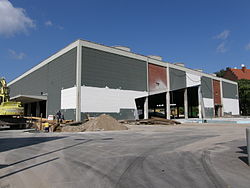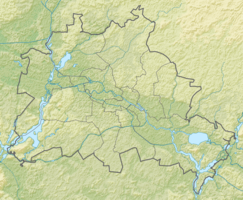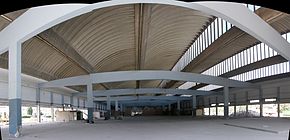Flower wholesale market hall (Berlin-Kreuzberg)
| Former wholesale flower market |
||
|---|---|---|
 Front view of the hall during the renovation for the Jewish Museum Berlin (August 2011) |
||
| Data | ||
| place | Berlin | |
| architect |
Bruno Grimmek (1963–1965) Daniel Libeskind (renovation 21st century) |
|
| Construction year | 1922; 1937 (new building); 1950s (repair); 1965 (new building); 2011/2012 (renovation) | |
| Floor space | 10,400 m² | |
| Coordinates | 52 ° 30 '10 .4 " N , 13 ° 23' 34.4" E | |
|
|
||
The wholesale flower market in Berlin's Friedrichstadt was first built in 1922 in the immediate vicinity of Markthalle II (Lindenhalle), in which several flower wholesalers have also had their stalls since it opened in 1886. In 1922 a separate hall for the flower wholesale market could be built. This was replaced by a new building from 1937. After it was destroyed in the Second World War , a temporary solution was built on the same site, which was replaced by a new building, the current hall, by 1965. In May 2010 the flower wholesale market moved to the Beusselstrasse wholesale market hall . The hall was sold and the renovation for the Jewish Museum Berlin began.
history
Original market hall II
The market hall II inside the block, accessed through the properties Lindenstrasse 97/98 and Friedrichstrasse 18, was opened in 1886. It was one of the 14 closed market halls from the building program of the Berlin magistrate to improve urban hygiene. Most of the 550 small market stalls offered fresh food from the Berlin area. But "34 of the 550 stallholders were already trading in flowers in this original hall, and the first wholesalers soon came because of the good heating." The 250 m² in this hall were soon no longer sufficient for the flower trade.
Extension and new building for the flower wholesale
The observatory that used to be in the neighborhood was relocated in 1912, the building was demolished and the site cleared. So the city planners had Charlottenstrasse, located in the north, extend straight across Enckeplatz (which was less of a square than a dead end ) to Lindenstrasse. The traffic route, first known as the Extended Charlottenstrasse , made a bend directly on the northeast wall of Markthalle II and continued in a south-easterly direction to Lindenstrasse. In the modesty of the post-war years, a wholesale flower market hall was built on part of the former observatory site, which was then called the sheepfold and opened in 1922. On February 18, 1927, the extended Charlottenstrasse was renamed Enckestrasse , reminding of the history of the observatory. The market hall II was given the address Enckestraße 12-14. The first wholesale flower market hall, now with the address Enckestrasse 11, was replaced from 1937 by a modern new building, which was named Blue Hall after the exterior color . “By the beginning of the Second World War, this was the largest transhipment point for flowers in Germany.” Since 1926, flowers from Amsterdam have been arriving regularly by air freight via the nearby Tempelhof airport to the wholesale market. During the US air raid on February 3, 1945 , the Blue Hall - as well as Markthalle II and many other buildings in the district - were destroyed.
Development of the halls after the Second World War
After the war, the flower wholesale market was housed in a reduced, provisional flower hall . Market Hall II, which was previously used for retail, was not rebuilt, but the war ruins were completely removed. The flower wholesale market also acquired the cleared property at Friedrichstrasse 18, which it used as a parking lot until 2010.
The southern section of Enckestrasse and the plots No. 1, 2, 3 and 12-14 were added to Enckestrasse 11, the site of the flower wholesale market, in 1963, and the breakthrough in Enckestrasse created after 1912 was redesigned , as was the traffic plan of the Kreuzberg city planning office from 1963 shows. The market hall property was divided along a line that was drawn at right angles to Friedrichstrasse at the level of the boundary between properties 15 and 16 to Lindenstrasse. The resulting shifted southern border of the wholesale market site no longer ran at right angles to Lindenstrasse, but to Friedrichstrasse. With the hall and the surrounding areas for driveways and parking spaces, the property forms an area of around 26,000 m².
A new wholesale flower market went into operation in 1965
To the north parallel to this line, Berliner Großmarkt GmbH, as operator, built a new wholesale flower market, which also included parts of the former location of Markthalle II and the former southern section of Enckestrasse. On November 25, 1963, the foundation stone for the new building was laid with the participation of Senator for Building Rolf Schwedler . The new market hall, a concrete frame building clad with exposed aggregate concrete slabs, was occupied on the eve of Green Week , January 28, 1965. The blueprints came from Bruno Grimmek . The single-storey hall made of concrete with shed roof elements contained around 6,436 m² of usable space, of which 3,340 were used as retail space. Enckestrasse, now a dead end, opens up the hall area from the north.
The flower wholesale market was the subject of the plans for the International Building Exhibition 1984–1987 (IBA) . In the early 1980s, the IBA demanded the relocation of the flower wholesale market and the demolition of the hall. But in 1982 the Senate made the requirement to integrate the wholesale market into urban development. In March 1983, an “international narrower competition - block 606 - design of a primary and special school in the urban context of the flower wholesale market and the planned Besselpark ” was announced, which Gino Valle, Mario Broggi and Michael Burkhart won in the summer of that year. In July 1984 the Senate decided to relocate the wholesale flower market within three to five years, but withdrew this decision in 1986 for financial reasons. The IBA then presented new plans for integrating the hall.
The entire area north of the wholesale flower market up to Besselstrasse, including parts of the property used for the northern development of the hall, was to be incorporated into the future Besselpark. However, the plans were abandoned in 1985 in favor of a competition for parks in southern Friedrichstadt . The plot of land was retained for the flower wholesale market in its previous extent and the park was only created north of it between Friedrichstrasse and Enckestrasse. This should enable an expansion of the flower wholesale market. This flexible concept convinced the jury of the competition.
The hall was renovated in 1998. In 2007 the Berlin architectural office Grüntuch Ernst prepared an expert opinion on the structural condition of the hall with an estimate of the renovation costs. The equipment in the hall was out of date. The 26 resident dealers complained of constant decline in sales. Because neither the city of Berlin, as the owner, nor the florists carried out maintenance measures, the Senate decided to relocate the wholesale flower market and use the hall for other purposes after renewed renovation. Because the subsequent use had not yet been determined in 2008, the hall was used for an art installation "KUNSTINVASION" on May 31 and June 1, 2008 after being temporarily vacated. The aim was to demonstrate a possible subsequent use of the hall by artists.
Total renovation of the hall for other uses
The florists were given alternative quarters in the Beusselstrasse wholesale market hall . But a new hall is being built there just for the florists. “The new wholesale flower market on Beusselstrasse has been open since May 16, 2010.” Between the departure of the flower wholesalers and the start of renovation in 2011, there were temporary uses by Berlin artists. Since then, many artists and galleries have also set up in the vicinity of the hall. Those responsible for the Senate had toyed with the idea of converting the historic building into the art gallery promised by the Governing Mayor Klaus Wowereit . After this project was canceled due to lack of money, the property was to be sold to an investor. It is not known whether there was an advertisement.
The reconstructed hall becomes the academy for the Jewish Museum
At the beginning of 2009 the Jewish Museum Berlin acquired the vacant hall. The museum management was able to convert the hall into the Academy of the Jewish Museum Berlin with the help of financial injections amounting to eleven million euros , of which 6.6 million were provided by the federal government and the rest comes from private donations . Since it opened, it has housed the museum's library, archive, education department and academy programs (on migration and diversity as well as Judaism and Islam). The interior design with a U-shaped floor plan in the shell of the previous building was designed by Daniel Libeskind , who had already provided the plans for the modern extension of the museum. The huge dimensions of the hall are a few sizes too big for the intended purpose, which is why an optical trick is used - three inclined wooden cubes "slide" out of the floor, are nested and ultimately form a house-in-house concept .
The rooms created in this way house office, seminar, meeting and depot rooms as well as a guest-student workshop. The reference library with adjoining reading room is located in one of the cubes, the other is used as an auditorium. The third cube forms the entrance to the building. The free area in the middle of the hall is designed as a garden of the diaspora according to the design of the French landscape architecture office atélier le balto . The 600 m² area is divided into four thematically designed levels: education , culture , nature and landscape . The spatial expansion of the museum was accompanied by a thematic expansion. The academy's programs focus on migration and diversity as well as the relationship between Judaism and Islam . The varied program of events consisting of readings, conferences, panel discussions and workshops offers a forum for interreligious, intercultural and socio-political exchange. The inauguration of the extension took place in November 2012. As a festive prelude, the international colloquium “Hear the truth, whoever speaks it” took place on November 18, 2012. This saying by the Jewish philosopher Moses Maimonides can also be found in five languages - German, English, Hebrew, Arabic and Judeo-Arabic - as a guiding principle on the facade of the building.
- gallery
Marketing and design of the remaining space
The remaining areas of the property that were once used for logistical development of the hall, but are no longer used after the conversion, are marketed separately in five parts. The tender process designated by the Senate with the working title Checkpoint Art therefore ran until November 15, 2011 . The connection between Enckestrasse and Lindenstrasse, which was interrupted in 1963, is to be reopened as a pedestrian passage, as can be seen in the landscape planning ideas and implementation competition Freiräume at the academy . The confluence of this promenade with Lindenstrasse is to be framed by new buildings to the north-east and south, and the resulting plaza will form the entrance to the Academy of the Jewish Museum. The concrete wall that separates the wholesale market from the bicycle parking spaces and the Ullmans sculpture at Lindenstrasse 91-95 will be removed in order to unite the areas in front of and behind. The district office had various suggestions for naming the square. The museum administration preferred naming it after Moses Mendelssohn , while the office referred to the decision to assign street or square names to women. So they finally agreed on the name Fromet-und-Moses-Mendelssohn-Platz , which was given on April 26, 2013.
According to plans by the Senate Department for Urban Development, the hall and the planned surrounding perimeter development should remain accessible to motorized traffic via Enckestrasse.
Web links
- Flower wholesale market Kreuzberg . In: District lexicon of the Luisenstädtischer Bildungsverein
- Academy of the Jewish Museum in the Eric F. Ross Building . Video documentation of the conversion of the flower wholesale market for use by the Jewish Museum Berlin
Individual evidence
- ↑ a b c d e f g Kreuzberg flower wholesale market will soon be history: The Senate has decided to move to the wholesale market on Beusselstrasse. The district is surprised and angry . In: Der Tagesspiegel , January 30, 2006.
- ↑ Kreuzberg flower wholesale market . In: District lexicon of the Luisenstädtischer Bildungsverein .
- ^ Topographischer Atlas Berlin: Unabridged study edition . Senate Department for Building and Housing Berlin / Surveying Department. Dietrich Reimer, Berlin 1995, p. 73, ISBN 3-496-02660-X .
- ↑ Encke Square . In: Street name lexicon of the Luisenstädtischer Bildungsverein
- ↑ a b c d e f g Kathrin Chod, Herbert Schwenk and Hainer Weißpflug, Berliner Bezirkslexikon: Friedrichshain-Kreuzberg , Berlin: Haude & Spener / Edition Luisenstadt, 2003, p. 100. ISBN 3-7759-0474-3 .
- ↑ Laurenz Demps , Carl-Ludwig Paeschke, Tempelhof Airport: The Story of a Legend , Berlin: Ullstein, 1998, p. 37. ISBN 3-550-06973-1 .
- ↑ a b c d e International Building Exhibition Berlin 1987 - project overview . Bauausstellung Berlin GmbH, Berlin 1987, p. 160. No ISBN.
- ^ Wolfgang Süchting: New school building in Friedrichstrasse / Lindenstrasse . In: Guide: Projects, Data, History , Reporting Year 1984. Senator for Building and Housing / International Building Exhibition Berlin 1984–1987. Berlin 1984, p. 88. No ISBN.
- ↑ a b International Building Exhibition Berlin 1987 - Project overview . Bauausstellung Berlin GmbH, Berlin 1987, p. 161. No ISBN.
- ↑ Grüntuch ( page no longer available , search in web archives ) Info: The link was automatically marked as defective. Please check the link according to the instructions and then remove this notice. under Projects 2007 , accessed on August 11, 2011
- ^ Initiative Berliner Kunsthalle , accessed on October 6, 2010
- ↑ Packing in the flower wholesale market. Last day in the Kreuzberger Halle before moving to Moabit. Almost half of the current dealers will not be represented in the new location . In: Der Tagesspiegel , May 15, 2010.
- ↑ "Flowers and Plants" ( Memento of the original from September 18, 2011 in the Internet Archive ) Info: The archive link was inserted automatically and has not yet been checked. Please check the original and archive link according to the instructions and then remove this notice. , on: Berlin wholesale market: The fresh produce and logistics center in the middle of Berlin ( page no longer available , search in web archives ) Info: The link was automatically marked as defective. Please check the link according to the instructions and then remove this notice. , accessed September 19, 2012.
- ↑ Example group art exhibition u. a. with Silvia Breitwieser
- ↑ a b Sebastian Preuss: Flowers and Education. The Jewish Museum grows across the street and expands the wholesale market hall into a visitor academy . In: Berliner Zeitung , August 11, 2011, p. 25.
- ↑ a b Result log of the closed landscape planning ideas and implementation competition Freiräume at the Academy ( Memento of the original from February 22, 2014 in the Internet Archive ) Info: The archive link was inserted automatically and has not yet been checked. Please check the original and archive link according to the instructions and then remove this notice. (PDF; 5.7 MB) Senate Department for Urban Development, accessed on September 19, 2012.
- ^ Südliche Friedrichstadt: Strategies for the Kreuzberg part of the historical center of Berlin - work report . (PDF, 5.97 MB) Senate Department for Urban Development, p. 33, accessed on May 29, 2012.









